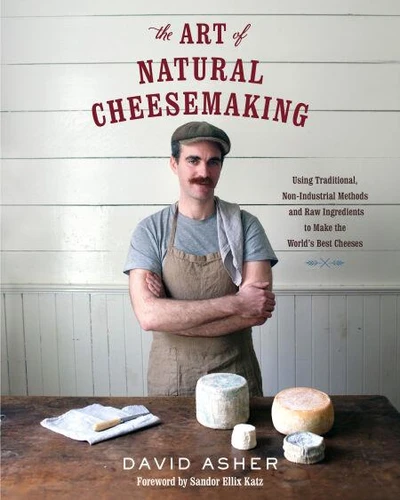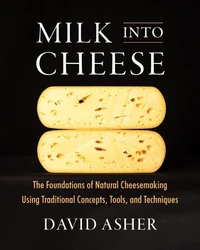The Art of Natural Cheesemaking. Using Traditional, Non - Industrial Methods and Raw Ingredients to Make the World's Best Cheeses
Par : ,Formats :
Disponible dans votre compte client Decitre ou Furet du Nord dès validation de votre commande. Le format ePub protégé est :
- Compatible avec une lecture sur My Vivlio (smartphone, tablette, ordinateur)
- Compatible avec une lecture sur liseuses Vivlio
- Pour les liseuses autres que Vivlio, vous devez utiliser le logiciel Adobe Digital Edition. Non compatible avec la lecture sur les liseuses Kindle, Remarkable et Sony
- Non compatible avec un achat hors France métropolitaine
 , qui est-ce ?
, qui est-ce ?Notre partenaire de plateforme de lecture numérique où vous retrouverez l'ensemble de vos ebooks gratuitement
Pour en savoir plus sur nos ebooks, consultez notre aide en ligne ici
- Nombre de pages320
- FormatePub
- ISBN978-1-60358-579-8
- EAN9781603585798
- Date de parution30/06/2015
- Protection num.Adobe DRM
- Taille37 Mo
- Infos supplémentairesepub
- ÉditeurChelsea Green
Résumé
Including more than 35 step-by-step recipes from the Black Sheep School of CheesemakingMost DIY cheesemaking books are hard to follow, complicated, and confusing, and call for the use of packaged freeze-dried cultures, chemical additives, and expensive cheesemaking equipment. For though bread baking has its sourdough, brewing its lambic ales, and pickling its wild fermentation, standard Western cheesemaking practice today is decidedly unnatural.
In The Art of Natural Cheesemaking, David Asher practices and preaches a traditional, but increasingly countercultural, way of making cheese-one that is natural and intuitive, grounded in ecological principles and biological science. This book encourages home and small-scale commercial cheesemakers to take a different approach by showing them:. How to source good milk, including raw milk;. How to keep their own bacterial starter cultures and fungal ripening cultures;.
How make their own rennet-and how to make good cheese without it;. How to avoid the use of plastic equipment and chemical additives; and. How to use appropriate technologies. Introductory chapters explore and explain the basic elements of cheese: milk, cultures, rennet, salt, tools, and the cheese cave. The fourteen chapters that follow each examine a particular class of cheese, from kefir and paneer to washed-rind and alpine styles, offering specific recipes and handling advice.
The techniques presented are direct and thorough, fully illustrated with hand-drawn diagrams and triptych photos that show the transformation of cheeses in a comparative and dynamic fashion. The Art of Natural Cheesemaking is the first cheesemaking book to take a political stance against Big Dairy and to criticize both standard industrial and artisanal cheesemaking practices. It promotes the use of ethical animal rennet and protests the use of laboratory-grown freeze-dried cultures.
It also explores how GMO technology is creeping into our cheese and the steps we can take to stop it. This book sounds a clarion call to cheesemakers to adopt more natural, sustainable practices. It may well change the way we look at cheese, and how we make it ourselves.
In The Art of Natural Cheesemaking, David Asher practices and preaches a traditional, but increasingly countercultural, way of making cheese-one that is natural and intuitive, grounded in ecological principles and biological science. This book encourages home and small-scale commercial cheesemakers to take a different approach by showing them:. How to source good milk, including raw milk;. How to keep their own bacterial starter cultures and fungal ripening cultures;.
How make their own rennet-and how to make good cheese without it;. How to avoid the use of plastic equipment and chemical additives; and. How to use appropriate technologies. Introductory chapters explore and explain the basic elements of cheese: milk, cultures, rennet, salt, tools, and the cheese cave. The fourteen chapters that follow each examine a particular class of cheese, from kefir and paneer to washed-rind and alpine styles, offering specific recipes and handling advice.
The techniques presented are direct and thorough, fully illustrated with hand-drawn diagrams and triptych photos that show the transformation of cheeses in a comparative and dynamic fashion. The Art of Natural Cheesemaking is the first cheesemaking book to take a political stance against Big Dairy and to criticize both standard industrial and artisanal cheesemaking practices. It promotes the use of ethical animal rennet and protests the use of laboratory-grown freeze-dried cultures.
It also explores how GMO technology is creeping into our cheese and the steps we can take to stop it. This book sounds a clarion call to cheesemakers to adopt more natural, sustainable practices. It may well change the way we look at cheese, and how we make it ourselves.
Including more than 35 step-by-step recipes from the Black Sheep School of CheesemakingMost DIY cheesemaking books are hard to follow, complicated, and confusing, and call for the use of packaged freeze-dried cultures, chemical additives, and expensive cheesemaking equipment. For though bread baking has its sourdough, brewing its lambic ales, and pickling its wild fermentation, standard Western cheesemaking practice today is decidedly unnatural.
In The Art of Natural Cheesemaking, David Asher practices and preaches a traditional, but increasingly countercultural, way of making cheese-one that is natural and intuitive, grounded in ecological principles and biological science. This book encourages home and small-scale commercial cheesemakers to take a different approach by showing them:. How to source good milk, including raw milk;. How to keep their own bacterial starter cultures and fungal ripening cultures;.
How make their own rennet-and how to make good cheese without it;. How to avoid the use of plastic equipment and chemical additives; and. How to use appropriate technologies. Introductory chapters explore and explain the basic elements of cheese: milk, cultures, rennet, salt, tools, and the cheese cave. The fourteen chapters that follow each examine a particular class of cheese, from kefir and paneer to washed-rind and alpine styles, offering specific recipes and handling advice.
The techniques presented are direct and thorough, fully illustrated with hand-drawn diagrams and triptych photos that show the transformation of cheeses in a comparative and dynamic fashion. The Art of Natural Cheesemaking is the first cheesemaking book to take a political stance against Big Dairy and to criticize both standard industrial and artisanal cheesemaking practices. It promotes the use of ethical animal rennet and protests the use of laboratory-grown freeze-dried cultures.
It also explores how GMO technology is creeping into our cheese and the steps we can take to stop it. This book sounds a clarion call to cheesemakers to adopt more natural, sustainable practices. It may well change the way we look at cheese, and how we make it ourselves.
In The Art of Natural Cheesemaking, David Asher practices and preaches a traditional, but increasingly countercultural, way of making cheese-one that is natural and intuitive, grounded in ecological principles and biological science. This book encourages home and small-scale commercial cheesemakers to take a different approach by showing them:. How to source good milk, including raw milk;. How to keep their own bacterial starter cultures and fungal ripening cultures;.
How make their own rennet-and how to make good cheese without it;. How to avoid the use of plastic equipment and chemical additives; and. How to use appropriate technologies. Introductory chapters explore and explain the basic elements of cheese: milk, cultures, rennet, salt, tools, and the cheese cave. The fourteen chapters that follow each examine a particular class of cheese, from kefir and paneer to washed-rind and alpine styles, offering specific recipes and handling advice.
The techniques presented are direct and thorough, fully illustrated with hand-drawn diagrams and triptych photos that show the transformation of cheeses in a comparative and dynamic fashion. The Art of Natural Cheesemaking is the first cheesemaking book to take a political stance against Big Dairy and to criticize both standard industrial and artisanal cheesemaking practices. It promotes the use of ethical animal rennet and protests the use of laboratory-grown freeze-dried cultures.
It also explores how GMO technology is creeping into our cheese and the steps we can take to stop it. This book sounds a clarion call to cheesemakers to adopt more natural, sustainable practices. It may well change the way we look at cheese, and how we make it ourselves.





